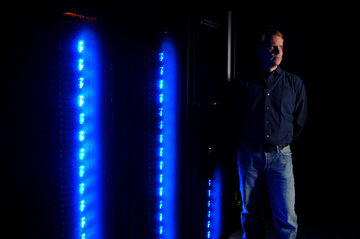|
||
      |
Next Generation
About a boson
In coming months University scientists will begin a hunt for the Higgs boson, a subatomic particle that, 43 years after it was first hypothesized, remains theoretical. Led by Robert Gardner (seen at right, with blue-lit stacks of computer servers), a Computation Institute researcher and Enrico Fermi Institute physicist, the team will sift through data swarming out of the Large Hadron Collider at Switzerland’s CERN particle-physics laboratory. There, as beams of protons collide at a rate of 40 million times per second, each collision will produce 23 proton interactions capable of creating subatomic particles.

Long-sought but still unseen, the Higgs boson is thought to endow all objects in the universe with mass (see “How to catch a Higgs,” April/01). With unprecedented power, the new collider can produce enough energy to create the Higgs boson. “If we don’t see it,” says Chicago physicist James Pilcher, “there’s going to be a great deal of consternation.” Scientists also will search for evidence of supersymmetric particles, which could help uncover extra dimensions.
Researchers from around the world will detect and sort proton-collision data flowing from CERN into a Chicago-run computer center. The local facility is part of a network linking 158 institutions in 35 countries in the ATLAS experiment (loosely, ATLAS stands for A Toroidal Large Hadron Collider Apparatus). The U of C comanages the center with Indiana University, splitting equipment, servers, and data storage between Hyde Park and IU’s Indianapolis campus. Dubbed the Midwest Tier-2 center, it’s one of five such centers in the U.S.